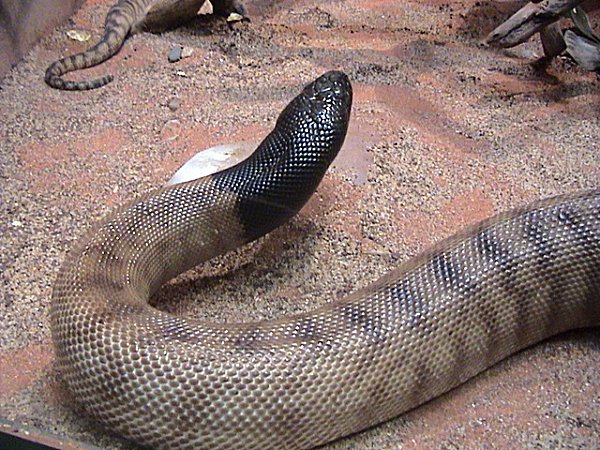|
| Query: Black-headed monitor | Result: 5th of 5 | |
Black-headed Python (Aspidites melanocephalus) - Wiki
| Subject: | Black-headed Python (Aspidites melanocephalus) - Wiki
| |

| Resolution: 600x450
File Size: 112107 Bytes
Upload Date: 2007:10:16 13:52:19
|
Aspidites melanocephalus
From Wikipedia, the free encyclopedia
[Photo] Black-headed Python (Aspidites melanocephalus) at the Cameron Park Zoo. Photo by http://en.wikipedia.org/wiki/User:Dawson
Common names: black-headed python.
Aspidites melanocephalus is a non-venomous python species found in Australia. No subspecies are currently recognized.
Description
This python grows to a maximum length of 3 m (9 feet), although average specimens are slightly smaller. The body is muscular with a flattened profile, while the tail tapers to a thin point.
The dorsal scales, which are smooth and glossy, number 50-65 rows at midbody, while there are 315-355 ventral scales. The tail has 60-75 mainly single subcaudal scales and the anal scale is single. The posterior subcaudals tend to be divided, often irregularly.
The color patter consists of shades of black and dark grey, brown, gold and cream arranged in a striped or brindled pattern. The belly light-coloured, flecked with darker spots. The head is covered in shiny black scales that also extend down the neck and throat for several inches.
Geographic range
Found in Australia in the northern half of the country, excluding the very arid regions. The type locality given is "Port Denison [Bowen]" [Queensland, Australia].
Habitat
Occurs in humid tropical to semi-arid conditions.
Behavior
These snakes are terrestrial snake and are often found in amongst rocks and loose debris. If disturbed, they will hiss loudly, but is unlikely to bite unless hunting prey. They will sometimes strike with a closed mouth, but generally can be handled easily. They are strong swimmers, but are almost never found in it.
Feeding
The diet consists of rats, mice, birds and other reptiles, such as the monitor lizards that share their habitat and other snakes, including venomous species. They are known to have a rapid metabolism and will feed often when able to bask in warm temperatures.
Reproduction
Oviparous, with 5-10 eggs per clutch. The females stay coiled about the eggs and incubate them until they hatch, which is usually after 2-3 months. The young will take small prey as soon as two days after hatching. Immature individuals are vulnerable to predation, including cannibalism. Adults have no natural predators other than dingos and humans.
Captivity
Due to its docile nature and striking color pattern, this species has become very desirable as an exotic pet. It is bred in captivity and can be relatively easily obtained, but does command a high price. As they can be muscular snakes and reach a fairly substantial size, prospective owners should consider an suitable enclosure, as well as temperature and feeding requirements.
In human culture
These snakes are mentioned in, or plays a central role in, the stories of the Indigenous Australians Dreamtime tradition.
http://en.wikipedia.org/wiki/Aspidites_melanocephalus
| The text in this page is based on the copyrighted Wikipedia article shown in above URL. It is used under the GNU Free Documentation License. You may redistribute it, verbatim or modified, providing that you comply with the terms of the GFDL. |
|
Comments |
|---|
| | Guest |
|
| How many Black-headed pythons are there in the world? |
| | Cialis |
|
| Erectile dysfunction, cialis, 3517, [URL=https://launchpad.net/~abtyjassar]cialis[/URL], b()), https://launchpad.net/~abtyjassar Cialis, umge. |
| | Pharme261 |
|
| Hello! edcdebb interesting edcdebb site! |
| | Pharmf188 |
|
| Very nice site! |
| | Pharmk276 |
|
| Hello! edekedc interesting edekedc site! |
| | Pharmg762 |
|
| Very nice site! |
^o^
Animal Pictures Archive for smart phones
^o^
|
|
|